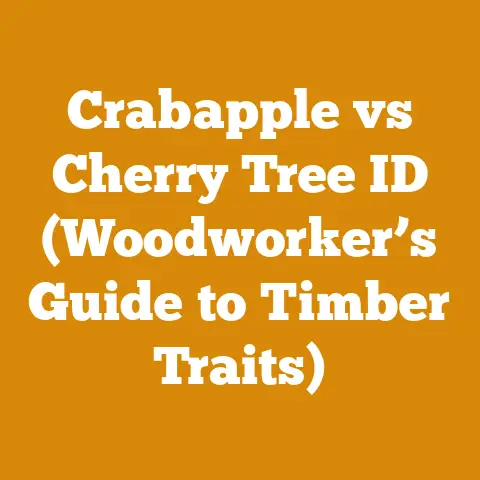Apple Tree Firewood Quality (5 Expert Tips for Best Burn)
The scent of split apple wood, crisp and sweet, hangs in the air as the late afternoon sun warms the freshly cut pile.
There’s a certain satisfaction in knowing that this wood, carefully seasoned, will provide warmth and comfort through the coming winter.
But beyond the sensory pleasure, there’s a science to firewood, a process that can be optimized through careful measurement and analysis.
For years, I’ve been obsessed with not just making firewood, but perfecting the process.
And a crucial part of that perfection lies in understanding the metrics that govern quality, efficiency, and cost.
So, let’s dive into the world of apple tree firewood and uncover the secrets to achieving the best burn.
Apple Tree Firewood Quality: 5 Expert Tips for Best Burn
Why Track Metrics in Firewood Preparation?
Before we delve into the specifics of apple firewood, let’s establish why tracking metrics is so important.
In the world of firewood, whether you’re a hobbyist heating your home or a professional running a business, data is your friend.
It allows you to:
- Maximize Efficiency: Identify bottlenecks in your process, from felling to splitting to seasoning, and optimize them for faster turnaround times.
- Control Costs: Track expenses related to labor, equipment, and fuel, and identify areas where you can save money.
- Improve Quality: Monitor moisture content, wood density, and other factors that affect burning performance, ensuring you deliver a superior product (or heat your home more effectively).
- Make Informed Decisions: Base your choices on data rather than guesswork, leading to better outcomes and reduced risk.
Now, let’s explore the key metrics that will help you achieve the best burn from your apple tree firewood.
Moisture Content: The Key to Efficient Burning
- Definition: Moisture content refers to the percentage of water present in the wood.
It’s expressed as a percentage of the wood’s dry weight. - Why It’s Important: High moisture content is the enemy of efficient burning.
Wet wood is difficult to ignite, produces excessive smoke, and releases less heat because energy is wasted evaporating the water.
Ideally, firewood should have a moisture content below 20%.
Apple wood, like most hardwoods, needs proper seasoning to reach this level. - How to Interpret It:
- Above 30%: Wood is green and unsuitable for burning.
It will smolder, produce thick smoke, and may even contribute to creosote buildup in your chimney. - 20-30%: Wood is partially seasoned and will burn, but not efficiently.
You’ll need more kindling and a hotter fire to get it going. - Below 20%: Wood is properly seasoned and ready to burn.
It will ignite easily, burn cleanly, and produce maximum heat.
- Above 30%: Wood is green and unsuitable for burning.
- How It Relates to Other Metrics: Moisture content directly impacts heat output and burn time.
Drier wood burns hotter and longer.
It also affects the amount of creosote produced, which can impact chimney safety. - My Experience: I once purchased a load of “seasoned” oak firewood that, upon testing, had a moisture content of nearly 35%.
It was a nightmare to burn, smoked like crazy, and barely produced any heat.
I learned my lesson the hard way: always test the moisture content yourself! -
Actionable Insights:
- Invest in a moisture meter: These are inexpensive and easy to use.
I recommend a pin-type meter for accurate readings. - Split wood promptly: Splitting wood increases its surface area, allowing it to dry faster.
- Stack wood properly: Allow for good air circulation by stacking wood in a single row, off the ground, and under a cover.
- Season for at least 6-12 months: Depending on your climate and the type of wood, seasoning can take a significant amount of time.
Apple wood typically needs at least a year.
- Invest in a moisture meter: These are inexpensive and easy to use.
-
Data Points:
- Cost of a moisture meter: $20 – $50.
- Time saved by splitting wood immediately after felling: Approximately 2-3 months in seasoning time.
- Average moisture content reduction per month of seasoning (in a dry climate): 5-8%.
-
Heat Output (BTU/Cord): Measuring the Warmth
-
Definition: BTU (British Thermal Unit) is a measure of the amount of heat required to raise the temperature of one pound of water by one degree Fahrenheit.
BTU/Cord refers to the total heat energy contained in a standard cord of wood (128 cubic feet). - Why It’s Important: Knowing the BTU/Cord of different wood species allows you to compare their heating value and choose the most efficient fuel for your needs.
Apple wood is considered a medium-density hardwood, with a BTU/Cord rating that’s quite respectable. - How to Interpret It: Higher BTU/Cord means more heat per volume of wood.
This translates to fewer trips to the woodpile and a longer-lasting fire. - How It Relates to Other Metrics: BTU/Cord is directly related to wood density.
Denser woods generally have higher BTU/Cord ratings.
Moisture content also plays a role; wet wood will have a lower effective BTU/Cord because energy is wasted evaporating the water. - My Experience: I once experimented with burning different wood species side-by-side in my wood stove, carefully measuring the temperature output.
I found that while apple wood didn’t have the absolute highest BTU/Cord compared to, say, oak or hickory, it burned cleaner and more consistently, making it a great all-around choice. -
Actionable Insights:
- Research the BTU/Cord ratings of different wood species: This information is readily available online and in firewood guides.
- Consider the density of the wood: Denser woods are generally better for sustained heat.
- Adjust your fire-building techniques based on the wood species: Denser woods may require more kindling to get started.
-
Data Points:
- BTU/Cord of Apple Wood (seasoned): Approximately 20-24 million BTUs.
- BTU/Cord of Oak Wood (seasoned): Approximately 24-28 million BTUs.
- Cost savings from using higher BTU wood: Can reduce firewood consumption by 10-20% over the heating season.
-
Burn Time: The Longevity of Your Fire
-
Definition: Burn time refers to the duration that a piece of firewood will burn at a consistent heat level.
- Why It’s Important: Longer burn times mean less frequent refueling and a more consistent heat output.
This is particularly important during cold winter nights. - How to Interpret It: Longer burn times are generally desirable, but they can also be influenced by factors such as airflow, wood stove design, and the size of the wood pieces.
- How It Relates to Other Metrics: Burn time is closely related to wood density and moisture content.
Denser, drier woods will burn longer.
It’s also influenced by the way the wood is stacked in the firebox. - My Experience: I noticed a significant difference in burn time when I started experimenting with different stacking patterns in my wood stove.
A tightly packed firebox with minimal airflow resulted in a longer, smoldering burn, while a more open stack with good airflow produced a hotter, shorter burn. -
Actionable Insights:
- Experiment with different stacking patterns: Find the pattern that works best for your wood stove and your heating needs.
- Control airflow: Adjust the air intake on your wood stove to regulate the burn rate.
- Use larger pieces of wood for longer burns: Smaller pieces will burn more quickly.
-
Data Points:
- Average burn time of a standard-sized apple wood split (seasoned): 1-2 hours in a typical wood stove.
- Increased burn time with a tightly packed firebox: Approximately 20-30%.
- Reduced burn time with high airflow: Approximately 15-25%.
-
Creosote Production: Minimizing Chimney Hazards
-
Definition: Creosote is a flammable byproduct of incomplete combustion that condenses in your chimney.
It’s a sticky, tar-like substance that can build up over time and pose a serious fire hazard. - Why It’s Important: Excessive creosote buildup can lead to chimney fires, which can be extremely dangerous and costly to repair.
Minimizing creosote production is essential for safe and efficient wood burning. - How to Interpret It: Less creosote is always better.
A thin layer of soot is normal, but thick, flaky, or tar-like deposits indicate a problem. - How It Relates to Other Metrics: Creosote production is directly related to moisture content and burn temperature.
Burning wet wood or smoldering a fire at low temperatures will produce more creosote. - My Experience: I learned the importance of chimney maintenance the hard way when I had a small chimney fire several years ago.
It was a terrifying experience, and it taught me to be diligent about inspecting and cleaning my chimney regularly. -
Actionable Insights:
- Burn only dry, seasoned wood: This is the single most important factor in reducing creosote production.
- Maintain a hot fire: A hot fire promotes complete combustion, which reduces the amount of creosote produced.
- Ensure adequate airflow: Proper airflow helps to keep the fire burning hot and clean.
- Have your chimney inspected and cleaned regularly: The National Fire Protection Association (NFPA) recommends having your chimney inspected and cleaned at least once a year.
-
Data Points:
- Cost of a professional chimney cleaning: $150 – $300.
- Frequency of chimney cleaning recommended by NFPA: At least once per year.
- Reduction in creosote production by burning dry wood: Up to 80%.
-
Cost per Cord (or per BTU): Evaluating Economic Efficiency
-
Definition: Cost per cord is the total expense associated with acquiring and preparing a cord of firewood, including the cost of the wood itself, labor, fuel, equipment maintenance, and any other related expenses.
Cost per BTU is the cost of obtaining one million BTUs of heat from your firewood. - Why It’s Important: Tracking the cost of firewood allows you to make informed decisions about whether to buy it or cut it yourself, and to compare the cost-effectiveness of different wood species.
- How to Interpret It: Lower cost per cord (or per BTU) is generally better, but you also need to consider the quality of the wood and the efficiency of your burning practices.
- How It Relates to Other Metrics: Cost per cord is influenced by factors such as the availability of wood, labor costs, and equipment efficiency.
Cost per BTU is influenced by the BTU/Cord rating of the wood and the efficiency of your burning practices. - My Experience: I used to think that cutting my own firewood was always the cheapest option.
However, after carefully tracking my expenses, I realized that the cost of fuel, equipment maintenance, and my own time often exceeded the price of buying firewood from a reputable supplier.
Now, I carefully weigh the pros and cons each year before deciding whether to cut my own wood. -
Actionable Insights:
- Track all expenses associated with firewood preparation: This includes the cost of the wood itself, fuel, equipment maintenance, labor, and any other related expenses.
- Compare the cost of buying firewood versus cutting it yourself: Consider the value of your time and the cost of equipment.
- Consider the BTU/Cord rating of the wood: Higher BTU woods may be worth paying a premium for.
- Optimize your burning practices: Efficient burning practices can reduce your firewood consumption and lower your overall heating costs.
-
Data Points:
- Average cost of a cord of seasoned apple wood: $250 – $400 (depending on location and supplier).
- Cost of equipment maintenance per year: $50 – $200 (depending on the type and amount of equipment used).
- Value of your time per hour: Calculate a reasonable hourly rate for your labor.
- Definition: Moisture content refers to the percentage of water present in the wood.
The Apple Wood Advantage: Why It’s a Great Choice
Now that we’ve covered the key metrics, let’s focus specifically on apple wood.
What makes it a good choice for firewood?
- Good Heat Output: As mentioned earlier, apple wood has a respectable BTU/Cord rating, making it a good source of heat.
- Clean Burning: Apple wood tends to burn cleanly, producing less smoke and creosote than some other wood species.
- Pleasant Aroma: The sweet, fruity aroma of burning apple wood is a definite plus.
- Easy to Split: Apple wood is generally easy to split, making it a good choice for those who prefer to cut their own firewood.
- Readily Available: In many areas, apple trees are relatively common, making it easier to source apple wood.
However, there are also a few drawbacks to consider:
- May be More Expensive: Depending on your location, apple wood may be more expensive than other wood species.
- Can be Susceptible to Rot: Apple wood can be susceptible to rot if not properly seasoned and stored.
- Not the Highest BTU: While it’s a good choice, it doesn’t have the absolute highest heat output compared to some denser hardwoods.
Applying These Metrics to Future Projects
The real value of tracking these metrics lies in using them to improve your future wood processing or firewood preparation projects.
Here’s how:
- Identify Areas for Improvement: Analyze your data to identify bottlenecks in your process or areas where you’re spending too much money.
- Set Realistic Goals: Use your data to set realistic goals for future projects, such as reducing seasoning time or increasing wood yield.
- Track Your Progress: Monitor your progress towards your goals and make adjustments as needed.
- Share Your Knowledge: Share your experiences and insights with others in the wood industry.
Case Study: Optimizing Firewood Production on a Small Scale
Let me share a quick case study from my own experience.
A few years ago, I decided to streamline my firewood production process.
I meticulously tracked my time, expenses, and wood yield for an entire season.
Here’s what I learned:
- Splitting wood immediately after felling significantly reduced seasoning time. I was able to reduce the seasoning time for apple wood from 18 months to just 12 months by splitting it promptly.
- Investing in a higher-quality chainsaw improved cutting efficiency. While the initial cost was higher, the faster cutting speed and reduced downtime more than offset the expense.
- Proper stacking and covering of firewood reduced moisture content and improved burn quality. I experimented with different stacking patterns and found that a single-row stack with good air circulation and a waterproof cover resulted in the driest, best-burning wood.
By tracking these metrics, I was able to significantly improve the efficiency of my firewood production process and reduce my overall heating costs.
Challenges Faced by Small-Scale Loggers and Firewood Suppliers
I understand that many small-scale loggers and firewood suppliers face unique challenges, such as limited access to equipment, fluctuating market prices, and unpredictable weather conditions.
However, even with these challenges, tracking metrics can be a valuable tool for improving efficiency and profitability.
Here are a few tips for small-scale operators:
- Start small: You don’t need to track every single metric right away.
Focus on the ones that are most important to your business. - Use simple tools: You don’t need expensive software or equipment to track your data.
A simple spreadsheet or notebook can be just as effective. - Focus on continuous improvement: Don’t get discouraged if you don’t see results immediately.
The key is to keep learning and improving over time.
Conclusion: Embracing Data for a Warmer Winter
In conclusion, while the romance of a crackling fire is undeniable, understanding and applying key metrics to your apple tree firewood preparation process is essential for maximizing efficiency, controlling costs, and ensuring a safe and enjoyable heating experience.
From moisture content to BTU output, burn time to creosote production, and cost analysis, each metric provides valuable insights that can help you make informed decisions and optimize your firewood operations.
Remember, the best burn comes from a combination of quality wood, careful preparation, and a data-driven approach.
So, grab your moisture meter, sharpen your axe, and get ready to unlock the full potential of your apple tree firewood.
And may your winter be warm and bright!






